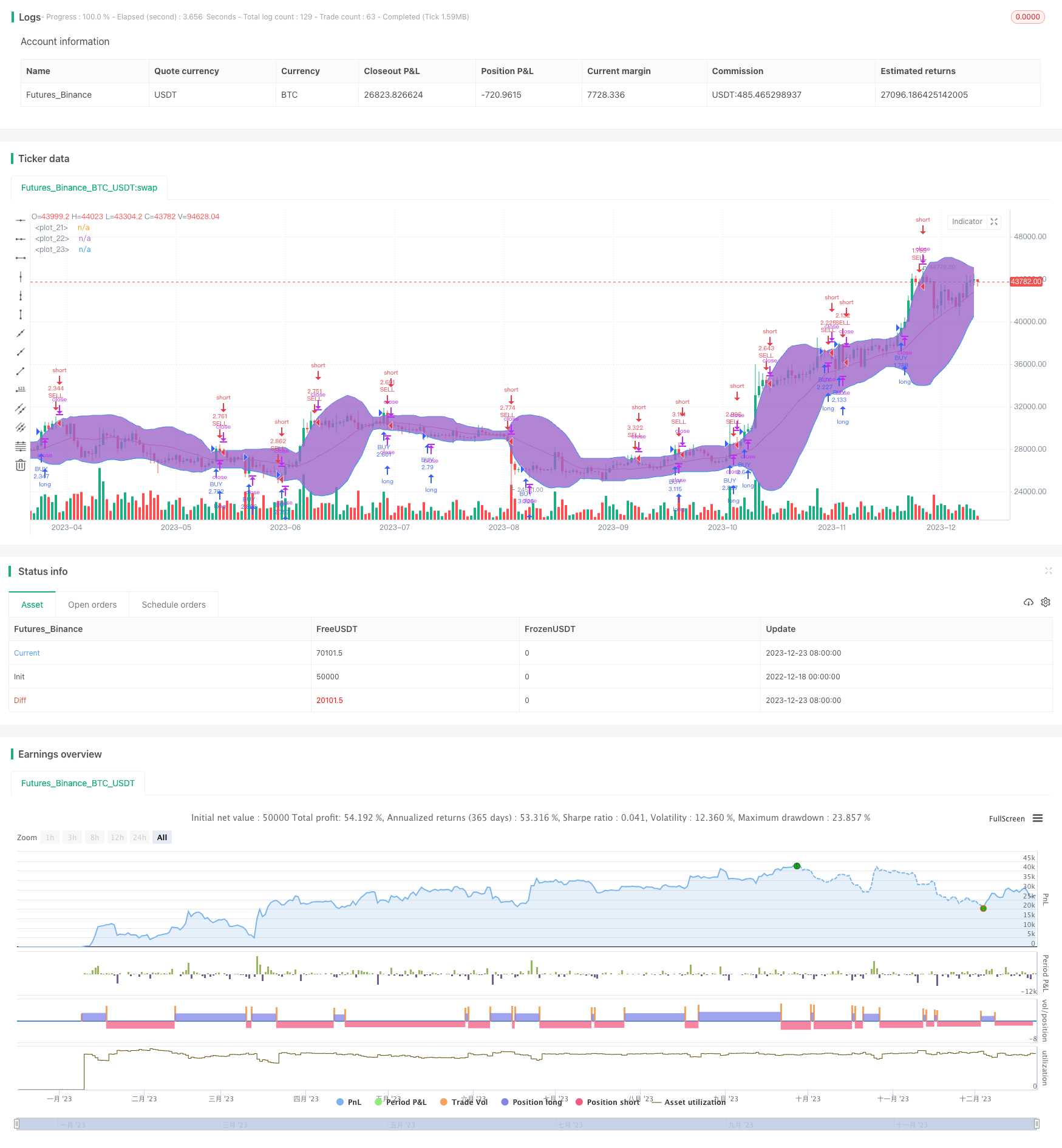
概述
双重布林带震荡跟踪策略是一种通过构建双重布林带,捕捉价格震荡进行跟踪的量化交易策略。该策略借助布林带的上下轨,实时捕捉市场的震荡机会。
策略原理
该策略首先计算N天的均线作为基准线,然后在均线的基础上按照标准差的若干倍计算出上下轨构建布林带。策略采用双重布林带,即上轨和下轨都是标准差的若干倍。在双重布林带形成后,当价格突破上轨时发出买入信号,当价格跌破下轨时发出卖出信号,通过这样的方式捕捉布林带上的价格震荡机会。
该策略同时设置了时间窗口,使得回测更加 TARGET,防止前期数据对测试产生影响。整个策略运作流程为:构建双重布林带、价格与轨道的交叉作为交易信号、设置时间窗口防止前期数据影响。
优势分析
该策略最大的优势在于能实时捕捉价格的震荡,通过布林带上下轨的突破来判断OPERATION方向。相比其他指标,布林带对市场的反应更为灵敏,可以在较短时间内形成交易信号。此外,双重布林带设置了更宽的通道,价格突破的可能性更大,可以抓住更多的交易机会。
风险分析
该策略主要的风险在于布林带构建依赖的参数N日和标准差倍数的设置。如果参数设置不当,将导致布林带变得太宽或太窄,从而错过交易机会或产生错误信号。此外,双边交易中没有设置止损,可能导致亏损扩大。
解决方法是优化参数,实时评估布林带的形态;另外是根据历史数据制定止损策略,控制单次亏损。
优化方向
该策略主要可以从以下几个方向进行优化:
优化布林带的参数,调整N日和标准差倍数,使布林带能更好地适应不同市场的特征。
增加续单机制,在原有订单获得一定利润后再次追加订单,扩大获利空间。
设置止损策略,当价格向不利方向突破布林带上下轨时止损出场,控制亏损。
结合其他指标筛选信号,避免在震荡市场中产生错误信号。
总结
双重布林带震荡跟踪策略通过构建双向布林带实时捕捉价格的震荡,能够在短期内抓住较多交易机会。该策略优势在于对市场变化灵敏,交易信号生成快速;风险主要来自参数设置不当和缺乏止损。我们可以通过多方位优化使该策略更稳定和高效。
/*backtest
start: 2022-12-18 00:00:00
end: 2023-12-24 00:00:00
period: 1d
basePeriod: 1h
exchanges: [{"eid":"Futures_Binance","currency":"BTC_USDT"}]
*/
//@version=3
strategy("BB_BB", overlay=true,default_qty_type=strategy.percent_of_equity, default_qty_value=100.0, pyramiding=0)
length = input(20, minval=1)
src = input(close, title="Source")
mult = input(2.0, minval=0.001, maxval=50)
FromMonth = input(defval = 1, title = "From Month", minval = 1, maxval = 12)
FromDay = input(defval = 1, title = "From Day", minval = 1, maxval = 31)
FromYear = input(defval = 2017, title = "From Year", minval = 2017)
ToMonth = input(defval = 1, title = "To Month", minval = 1, maxval = 12)
ToDay = input(defval = 1, title = "To Day", minval = 1, maxval = 31)
ToYear = input(defval = 9999, title = "To Year", minval = 2017)
start = timestamp(FromYear, FromMonth, FromDay, 00, 00) // backtest start window
finish = timestamp(ToYear, ToMonth, ToDay, 23, 59) // backtest finish window
window() => true // create function "within window of time"
basis = sma(src, length)
dev = mult * stdev(src, length)
upper = basis + dev
lower = basis - dev
plot(basis, color=red)
p1 = plot(upper, color=blue)
p2 = plot(lower, color=blue)
fill(p1, p2)
buy = crossover(sma(close,1), upper) or crossover(sma(close,1), lower)
sell = crossunder(sma(close,1), upper) or crossunder(sma(close,1), lower)
if(buy)
strategy.entry("BUY", strategy.long, when = window())
if(sell)
strategy.entry("SELL", strategy.short, when = window())